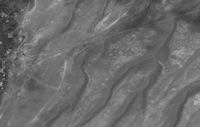
Rahimli detail of extensive Kurgan field
Modern western involvement in the country's archaeology began in 1995 with the environmental assessment of Sangachal Terminal site on the shores of the Caspian Sea. Professor Rashid Geyuchov was asked if he had experience of aerial photography in detecting archaeological sites. His reply was that he had been taken up several times in a helicopter, but had not seen any archaeological features. Aerial archaeology was not much use in Azerbaijan because 'many of the sites were so deeply buried'. Rog Palmer (Palmer and Zuk 2002) looked through all the available aerial photography and saw many interesting features [view report in digital archive], yet of the 50 or so archaeological sites excavated on the BTC pipeline route none presented any evidence that could be seen on aerial imagery. The most that could be said for the BTC project is that its imagery provides a view of the surrounding environment following fieldwork on each site. It also demonstrates that, in many instances, the modern landscape is completely divorced from the historic evidence underneath.
The modern state of Azerbaijan lies west of the Caspian and is dominated in the north by the Big Caucasus Mountains, the broad plain of the Kura Valley, and the range of the Little Caucasus Mountains to the south, with a coastal strip along the Caspian that includes the Absheron Peninsular. To the south-west is the Nakhivan Region, bordered by Turkey, Iran and Armenia. The climate is a hot continental one that gives areas of semi-desert; the majority of arable land, certainly in the Kura Valley, requires irrigation to produce crops - a classical lowland (ploughed, indeed bulldozed in some areas) and upland (transhumant sheep herding) with multi-period palimpsest landscapes.
As work associated with various oil-related developments has progressed over the past decade, so the various sources of aerial images and technological tools have improved. There has been, in consequence, a sharp increase in the learning curve of the researchers on the ground.
An early source of images from the BTC project was a set of vertical black and white images taken in 2001. Unfortunately these were not geo-located, and the accompanying poor-quality maps meant they were difficult to use easily. They were, however, useful in that they covered a wide range of areas greatly exceeding the pipeline corridor. These images came into their own later, when high-resolution Global Earth images became available, which allowed them to be better geo-located. The black and white images, with their greater contrast, show up features such as small kurgan mounds more clearly than Google Earth images. The six-year difference in date is now being used to show changes in the landscape - particularly to show damage to archaeological features.
The second source was a series of geo-referenced colour images for the pipeline route covering about 1km in width. These were the ones used by Rog Palmer, backed by specific black and white images. The series was very good, with high resolution and precision, but unfortunately as the pipeline followed a line through the lowland ploughed terrain, was not very successful in identifying archaeological features. The majority of such sites showed on the surface as potsherd scatters. A useful adjunct to Palmer's survey would have been a ground investigation survey looking at the evidence on the ground and comparing it with the aerial images, but this didn't happen mainly because most of the features were over 1km from the pipeline route.
Experience of sites on the ground over the following few years, particularly using handheld GPS to record positions, created a list of over 600 features that were located on the project GIS. Additional information came from other workers, e.g. Phil Kohl's list of GPS locations of features on the Gilgilchai Barrier. Many of the sites of major interest, such as Ganja and Shamkir medieval towns, were identified by this time.
The final major development was the arrival in late 2007 of high-resolution Google Earth images. Using these allowed, via KML files, all the collected data to be examined against real landscape views.
Several examples of the combined benefits are listed below.
It is perhaps true that some of the archaeology of Azerbaijan is 'deeply buried', but other parts are all too visible on the surface. It is these parts that are increasingly at risk of destruction from the escalating alteration of the landscape of Azerbaijan from oil-related development, quarrying and urban growth. Ground surveys are needed to verify details seen on aerial photographs. State Geodesy images and US Corona images from the 1960s could be used to illustrate the change over the past generation of Azerbaijan's landscape.
© Internet Archaeology/Author(s)
University of York legal statements | Terms and Conditions
| File last updated: Fri Jun 17 2011